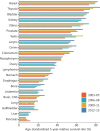Current cancer burden in China: epidemiology, etiology, and prevention
- PMID: 36069534
- PMCID: PMC9425189
- DOI: 10.20892/j.issn.2095-3941.2022.0231
Current cancer burden in China: epidemiology, etiology, and prevention
Abstract
Cancer has become the most common cause of death in China. Owing to rapid economic development, improved livelihood, and shifts in risk factors, cancer epidemiology has experienced substantial changes during the past several decades. In this review, we aim to describe the current cancer epidemiology of the main types of cancer in China, report major risk factors associated with cancer development, and summarize the contributions of the Chinese government to controlling the cancer burden. A total of 4,064,000 new cases were diagnosed in China in 2016. The most frequent types are lung cancer (828,100; 20.4%), colorectal cancer (408,000; 10.0%), and gastric cancer (396,500; 9.8%). Lung (657,000; 27.2%), liver (336,400, 13.9%), and stomach (288,500; 12.0%) cancers are the 3 most deadly cancers in the general population. The 5-year survival rate for cancer has dramatically increased in recent decades. However, liver and particularly pancreatic cancers still have the poorest prognosis. The main modifiable risk factors associated with cancer development include infectious agents, smoking, alcohol consumption, obesity, unhealthful dietary habits, and inadequate physical activity. The Chinese government has made unremitting efforts to decrease the cancer burden, including cancer education and investment in cancer screening programs.
Conflict of interest statement
No potential conflicts of interest are disclosed.
Figures




References
-
- Wei W, Zeng H, Zheng R, Zhang S, An L, Chen R, et al. Cancer registration in China and its role in cancer prevention and control. Lancet Oncol. 2020;21:e342–9. - PubMed
-
- Chen W, Zheng R, Baade PD, Zhang S, Zeng H, Bray F, et al. Cancer statistics in China, 2015. CA Cancer J Clin. 2016;66:115–32. - PubMed
-
- National Bureau of Statistics of China. [[Cited 2022 April 5]];China Statistical Yearbook. Available from: http://www.stats.gov.cn/tjsj/ndsj/
Publication types
MeSH terms
LinkOut - more resources
Full Text Sources
Medical
Miscellaneous
